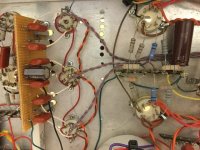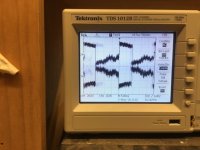I thought I'd cleanup my messy DIY amp so I rearranged the wiring a bit. But now I'm getting ghost notes. It's only on the initial string hit starting at volume 7 when amp start to distort. So when I play muted bottom strings it's sounds kind of like a popping thunder. Only thing I can think of is that the negative feedback wire might be to close to the power tubes now. It is not shielded, does it normal have to be?
I should have left the mess Thanks
Thanks
I should have left the mess
I thought I'd cleanup my messy DIY amp so I rearranged the wiring a bit. But now I'm getting ghost notes. It's only on the initial string hit starting at volume 7 when amp start to distort. So when I play muted bottom strings it's sounds kind of like a popping thunder. Only thing I can think of is that the negative feedback wire might be to close to the power tubes now. It is not shielded, does it normal have to be?
I should have left the messThanks
Unless you really, really wrap it around the output tube, it shouldn't do this.
What else did you rearrange? Input wiring, ground connections?
Could it be that you forgot a connection?
Is the gain of the amp still the same, or does it need more/less on the volume control?
Jan
I ground the other end, because I consider the input ground to be the reference. The shield is connected to the output transformer low side, but only connected to chassis ground at the same node/terminal as the input stage grid leak resistor. This also allows the return current for the feedback itself to flow through the shield, which both electrostatically and magnetically shields the feedback signal.
Lead dress is extremely important for stability, even in stages with low gain. Things you don’t expect to make a difference can. The bias board at the left of the photo was originally located at that second set of holes to the right of the k-followers, with the coupling caps flying over the stage back to the phase splitter. Couldn’t get the stage stable, and it’s unity gain, dammit! Even with no feedback, or even output tubes. Get the signal level above a certain point, and the followers would regenerate and drive straight to clipping. Square wave clipping, and asymmetrical to boot. That would have made some NASTY popping sounds. After a lot of head scratching the only thing it could have been is unintentional coupling. Moving the bias board and putting the coupling caps on it to minimize lengths fixed it immediately.
Attachments
Unless you really, really wrap it around the output tube, it shouldn't do this.
What else did you rearrange? Input wiring, ground connections?
Could it be that you forgot a connection?
Is the gain of the amp still the same, or does it need more/less on the volume control?
Jan
I've only shortened wires through out the amp and made them neater. Didn't change any grounding or anything else. I've now also noticed that sometimes some bass notes are ghosting about an octave lower and some bass notes are louder than others. Strange part is that it's not the same all the time, it seems to come and go. I have shielded wires to input stage and from 1st to 2th stage but not the NF so I was wondering if it has to have it or not before I pull everything out again.
I'll disconnect the NF and see what it does.
I've only shortened wires through out the amp and made them neater. Didn't change any grounding or anything else. I've now also noticed that sometimes some bass notes are ghosting about an octave lower and some bass notes are louder than others. Strange part is that it's not the same all the time, it seems to come and go. I have shielded wires to input stage and from 1st to 2th stage but not the NF so I was wondering if it has to have it or not before I pull everything out again.
I'll disconnect the NF and see what it does.
Don't run it without the NF (if you mean negative feedback with NF), it may damage the amp or speaker from huge overdrive.
Jan
Again, as was asked earlier, please post a schematic.
Shooting Arrows with a blindfold on does not get the Bullseye.
Did you add the shielded wire from 1st to 2nd stage, when you cleaned up the amp?
That might change the phase delay there, and now, negative feedback is unstable (perhaps).
Shooting Arrows with a blindfold on does not get the Bullseye.
Did you add the shielded wire from 1st to 2nd stage, when you cleaned up the amp?
That might change the phase delay there, and now, negative feedback is unstable (perhaps).
Last edited:
I took the NFB off and the ghosting was gone. So I've put in shielded wire and ghosting it's back even at different wire position. It's weird. I've got 820 ohm NFB like Deluxe Reverb, the amp is same design except instead of fixed bias I used cathode bias. But it was fine before I started making it look pretty. Maybe the 820 ohm is too low and now it's oscillating. The chances are that my layout and grounding aren't all that perfect like the real deal. I'll try increasing the value.
Last edited:
This sounds more like harmonic distortion which NFB decreases, are you sure your not feeding it positive FB? Does gain go up when "NFB" is applied?
To find the right NFB resistor use a 5k pot first, adjust till things are optimum, take pot out, read, replace with fixed R.
Lastly, check, re check, and then recheck your work, we've all done it, had a senior moment and screwed up somewhere, easily done.
Andy.
To find the right NFB resistor use a 5k pot first, adjust till things are optimum, take pot out, read, replace with fixed R.
Lastly, check, re check, and then recheck your work, we've all done it, had a senior moment and screwed up somewhere, easily done.
Andy.
If its not the same transformer you are using then yes the NFB may need altering. Could you sketch you mods. From what you describe it could be HF instability or motor-boating (LF) difficult without a waveform. Bypassed cathode bias can cause crossover distortion when the amp is hard driven - this can also affect NFB stability both and HF (due to drop in gain) and LF (due the values of the bypass caps).
Last edited:
Well I've tried different values but that didn't help so I've started taking things out one by one. I will also add shielding from 2th stage as suggested to splitter and see f it helps. I've made a sample, perhaps someone have came across this before. I'm playing muted string here it's very apparent there, than a chord which sounds ok but still have slight underlay of "something dirty". Amp is at max level.
Sample is here - Vocaroo | Voice message
Looks like I'm about rebuild the whole thing, grrrr!
Sample is here - Vocaroo | Voice message
Looks like I'm about rebuild the whole thing, grrrr!
Not refusing, just forgot the post. Here it is, basic Deluxe reverb, the only change is the bias and 5751 on splitter instead of 12AT7 because that's all I have, almost the same gain. I tried 12AX7 and that didn't make much difference anyway.
This is just temporary schematic without power supply yet. It is SS rectified one and it's not the problem I'm sure of that.
Fender Amp Deluxe reverb BASIC REBUILD — Postimages
This is just temporary schematic without power supply yet. It is SS rectified one and it's not the problem I'm sure of that.
Fender Amp Deluxe reverb BASIC REBUILD — Postimages
Last edited:
I just made the wiring more compact. In the mean time I added shielded wire from stage 1-2, it made no difference so I took that off again. Same with the NFB, shielded wire didn't help either so I reverted it.
Here is the chassis, yeah looks scary but it's not, it's just build in an old radio chassis.
I'm just thinking if the ghosting can't be caused by the shielded input cable (the white one). It's a bit long with nowhere else to route it. It's microphonic when I tap on it at full gain. I also have the input 1M (forgot to add on the schema)and 68k on the tube pins, not on the input socket, Could that make difference?
amp — Postimages
Here is the chassis, yeah looks scary but it's not, it's just build in an old radio chassis.
I'm just thinking if the ghosting can't be caused by the shielded input cable (the white one). It's a bit long with nowhere else to route it. It's microphonic when I tap on it at full gain. I also have the input 1M (forgot to add on the schema)and 68k on the tube pins, not on the input socket, Could that make difference?
amp — Postimages
Last edited:
- Status
- This old topic is closed. If you want to reopen this topic, contact a moderator using the "Report Post" button.
- Home
- Amplifiers
- Tubes / Valves
- Negative feedback shielding

